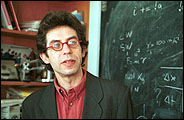Technology that pushes back
Remember when graphical user interfaces (GUI) were revolutionary? Today everyone has a "point and click" system on his home PC. McGill scientists are now working on the next level, haptic interfaces.
 Professor Vincent Hayward
Professor Vincent HaywardPHOTO: Owen Egan |
|
"People have five senses; they can hear, taste, smell, see and touch. Haptic interfaces appeal to the sense of touch," says Professor Vincent Hayward of the McGill Centre for Intelligent Machines.
"Experiencing the world around you by touch normally involves movement of your hands or other parts of your body over objects, and experiencing the feedback that comes from that. A mouse and a keyboard, which is how people experience graphical user interfaces, are inanimate objects and don't offer feedback."
Haptic interfaces can integrate tactile feedback to move a GUI beyond the visual component.
"Haptic interfaces can give computer icons a texture. For example, when you pull down a menu, you feel resistance, as if you're pulling on it. Or you feel a weight when you pick up an item. That is an application of haptic interfaces for routine tasks."
Computer users contending with a visual disability profit from having access to the sort of "touchy-feely" interfaces with their machines that Hayward and his collaborators are refining.
This first-generation application is currently available in specially designed computer mouses available from Immersion Canada Inc., a company which uses technology developed by Hayward and his graduate students. Immersion recently purchased a local spin-off from Hayward's research, Haptic Technologies Inc. Hayward holds the post of senior haptics scientist at Immersion.
Hayward, as well as colleagues and rivals worldwide, are now racing to develop the next generation. He says that his work is part of an explosion of research into this new computer frontier.
"Ten years ago, you could count on the fingers of one hand the labs working on this. Now every university has a haptic lab. And, if you look at the publication rate in the field, there used to be a few papers per year; now there's a few thousand."
The applications are nearly limitless, including driving simulator games; Hayward is working on a haptic steering wheel "which can be programmed to give you the sensation of driving a car; vibrations in the road, resistance on a sharp turn, etc."
But medical applications are the Holy Grail for many haptic researchers.
"The number one idea that was suggested a long time ago is developing simulations of surgical procedures, with a sufficient degree of realism, which could be used to train surgeons."
Hayward and graduate students Mosheu Mahvasli and Ping Rong Yi are working on two medical applications: simulating a minimally invasive surgical procedure in the abdominal cavity, and a specific brain surgery procedure. The tactile feedback they are developing could eventually be integrated into a complete surgical simulation involving sight, smell and touch.
"The number one problem is to simulate the interaction when a surgeon uses an instrument against tissue. You need to be able to calculate the deformation of the tissue with plausible fidelity. That involves hundreds of updates per second." This is accomplished by mathematical models created with algorithms.
The initial data to be reproduced is the actual feeling that a surgeon would experience when using his instruments to perform a specific surgical procedure. That data is collected with the help of sensors attached to surgical instruments. The sensors record the surgeon's movements, and the recording is fed into a computer.
Hayward says the applications he develops are, for him, not just means to a highly specialized end, but more a way of focusing his fundamental research.
"When you're working in a university, you have little understanding of the [potential] applications of your work. So we pick one or two of them, as a motivation, and it's up to industry to decide which ones are valuable to them.
"There are so many thousands of things we could do that we have to anchor our research in a few cases. If we choose very hard examples to work on, that helps us develop fundamental research techniques... We're interested in solving long-term problems which will result in better applications in the future."
Hayward's research is sponsored by the Institute for Robotics and Intelligent Systems (IRIS), a network of centres of excellence.

